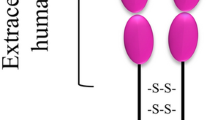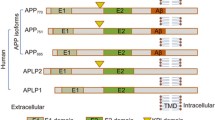Abstract
Purpose
It has been shown that amyloid β (Aβ) oligomers play an important role in the pathology of Alzheimer’s disease (AD). D3, a peptide consisting solely of d-enantiomeric amino acid residues, was developed to specifically eliminate Aβ oligomers and is therapeutically active in transgenic AD mice. d-peptides have several advantages over l-peptides, but little is known about their pharmacokinetic potential in vivo. Here, we analysed the pharmacokinetic properties of RD2, a rationally designed and potent D3 derivative.
Methods
The pharmacokinetic analysis was performed using 3H-RD2 after administration via several routes in mice. The time dependent amount of radiolabelled RD2 was measured in plasma and several organ homogenates by liquid scintillation counting. Furthermore, binding to plasma proteins was estimated.
Results
RD2 penetrates into the brain, where it is thought to implement its therapeutic function. All administration routes result in a maximal brain concentration per dose (Cmax/D) of 0.06 (μg/g)/(mg/kg) with brain/plasma ratios ranging between 0.7 and 1.0. RD2 shows a small elimination constant and a long terminal half-life in plasma of more than 2 days. It also exhibits high bioavailability after i.p., s.c. or p.o. administration.
Conclusions
These excellent pharmacokinetic properties confirm that RD2 is a very promising drug candidate for AD.





Similar content being viewed by others
Abbreviations
- %ID:
-
Relative injected dose
- AD:
-
Alzheimer’s disease
- AGP:
-
α1-acid glycoprotein
- AUC:
-
Area under the concentration-time curve
- AUMC:
-
Area under the moment curve
- Aβ:
-
Amyloid β
- C:
-
Concentration
- Cl:
-
Clearance
- D:
-
Dose
- dpm:
-
Disintegrations per minute
- F:
-
Bioavailability
- fu :
-
Unbound fraction
- HSA:
-
Human serum albumin
- i.p.:
-
Intraperitoneal
- i.v.:
-
Intravenous
- inf:
-
Infinity
- MAT:
-
Mean absorption time
- MRT:
-
Mean residence time
- n.i.v.:
-
Non-intravenous
- p.o.:
-
per os, oral delivery
- r2 :
-
Correlation coefficient
- s.c.:
-
Subcutaneous
- t1/2 :
-
Terminal half-life
- TLC:
-
Thin layer chromatography
- Vss :
-
Distribution volume in steady state
- Vz :
-
Terminal distribution volume
- λz :
-
Terminal elimination rate constant
References
Reitz C, Mayeux R. Alzheimer disease: epidemiology, diagnostic criteria, risk factors and biomarkers. Biochem Pharmacol. 2014;88(4):640–51.
Alzheimer’s Association. 2014 Alzheimer’s disease facts and figures. Alzheimers Dement. 2014;10(2):e47–92.
Soto C. Plaque busters: strategies to inhibit amyloid formation in Alzheimer’s disease. Mol Med Today. 1999;5(8):343–50.
Hardy JA, Higgins GA. Alzheimer’s disease: the amyloid cascade hypothesis. Science. 1992;256(5054):184–5.
Benilova I, Karran E, De Strooper B. The toxic a beta oligomer and Alzheimer’s disease: an emperor in need of clothes. Nat Neurosci. 2012;15(3):349–57.
DaRocha-Souto B, Scotton TC, Coma M, Serrano-Pozo A, Hashimoto T, Serenó L, et al. Brain oligomeric beta-amyloid but not total amyloid plaque burden correlates with neuronal loss and astrocyte inflammatory response in amyloid precursor protein/tau transgenic mice. J Neuropathol Exp Neurol. 2011;70(5):360–76.
Decker H, Lo KY, Unger SM, Ferreira ST, Silverman MA. Amyloid-beta peptide oligomers disrupt axonal transport through an NMDA receptor-dependent mechanism that is mediated by glycogen synthase kinase 3 beta in primary cultured hippocampal neurons. J Neurosci. 2010;30(27):9166–71.
Hardy J, Selkoe DJ. The amyloid hypothesis of Alzheimer’s disease: progress and problems on the road to therapeutics. Science. 2002;297(5580):353–6.
Sun N, Funke SA, Willbold D. A survey of peptides with effective therapeutic potential in Alzheimer’s disease rodent models or in human clinical studies. Mini Rev Med Chem. 2012;12(5):388–98.
Sato AK, Viswanathan M, Kent RB, Wood CR. Therapeutic peptides: technological advances driving peptides into development. Curr Opin Biotechnol. 2006;17(6):638–42.
Pauletti GM, Gangwar S, Siahaan TJ, Aubé J, Borchardt RT. Improvement of oral peptide bioavailability: peptidomimetics and prodrug strategies. Adv Drug Deliv Rev. 1997;27(2–3):235–56.
van Regenmortel MHV, Muller S. D-peptides as immunogens and diagnostic reagents. Curr Opin Biotechnol. 1998;9(4):377–82.
Soto C, Kindy MS, Baumann M, Frangione B. Inhibition of Alzheimer’s amyloidosis by peptides that prevent beta-sheet conformation. Biochem Biophys Res Commun. 1996;226(3):672–80.
Sela M, Zisman E. Different roles of D-amino acids in immune phenomena. FASEB J. 1997;11(6):449–56.
Dintzis HM, Symer DE, Dintzis RZ, Zawadzke LE, Berg JM. A comparison of the immunogenicity of a pair of enantiomeric proteins. Proteins Struct Funct Genet. 1993;16(3):306–8.
Findeis MA, Musso GM, Arico-Muendel CC, Benjamin HW, Hundal AM, Lee JJ, et al. Modified-peptide inhibitors of amyloid beta-peptide polymerization. Biochemistry. 1999;38(21):6791–800.
Poduslo JF, Curran GL, Kumar A, Frangione B, Soto C. beta-sheet breaker peptide inhibitor of Alzheimer’s amyloidogenesis with increased blood–brain barrier permeability and resistance to proteolytic degradation in plasma. J Neurobiol. 1999;39(3):371–82.
Schumacher TNM, Mayr LM, Minor DL, Milhollen MA, Burgess MW, Kim PS. Identification of D-peptide ligands through mirror-image phage display. Science. 1996;271(5257):1854–7.
Wiesehan K, Willbold D. Mirror-image phage display: aiming at the mirror. Chembiochem. 2003;4(9):811–5.
Funke SA, van Groen T, Kadish I, Bartnik D, Nagel-Steger L, Brener O, et al. Oral treatment with the D-enantiomeric peptide D3 improves the pathology and behavior of Alzheimer’s disease transgenic mice. ACS Chem Neurosci. 2010;1(9):639–48.
van Groen T, Kadish I, Funke A, Bartnik D, Willbold D. Treatment with a beta 42 binding D-amino acid peptides reduce amyloid deposition and inflammation in APP/PS1 double transgenic mice. Adv Protein Chem Struct Biol. 2012;88:133–52.
van Groen T, Wiesehan K, Funke SA, Kadish I, Nagel-Steger L, Willbold D. Reduction of Alzheimer’s disease amyloid plaque load in transgenic mice by D3, a D-enantiomeric peptide identified by mirror image phage display. ChemMedChem. 2008;3(12):1848–52.
van Groen T, Kadish I, Wiesehan K, Funke SA, Willbold D. In vitro and in vivo staining characteristics of small, fluorescent, Aβ42-binding D-enantiomeric peptides in transgenic AD mouse models. ChemMedChem. 2009;4(2):276–82.
van Groen T, Kadish I, Funke SA, Bartnik D, Willbold D. Treatment with D3 removes amyloid deposits, reduces inflammation, and improves cognition in aged AbetaPP/PS1 double transgenic mice. J Alzheimers Dis. 2013;34(3):609–20.
Olubiyi OO, Frenzel D, Bartnik D, Glück JM, Brener O, Nagel-Steger L, et al. Amyloid aggregation inhibitory mechanism of arginine-rich D-peptides. Curr Med Chem. 2014;21(12):1448–57.
Larson ME, Lesne SE. Soluble Abeta oligomer production and toxicity. J Neurochem. 2012;120 Suppl 1:125–39.
Ferreira ST, Klein WL. The Abeta oligomer hypothesis for synapse failure and memory loss in Alzheimer’s disease. Neurobiol Learn Mem. 2011;96(4):529–43.
Brown RP, Delp MD, Lindstedt SL, Rhomberg LR, Beliles RP. Physiological parameter values for physiologically based pharmacokinetic models. Toxicol Ind Health. 1997;13(4):407–84.
Pollaro L, Heinis C. Strategies to prolong the plasma residence time of peptide drugs. Med Chem Commun. 2010;1(5):319–24.
Renukuntla J, Vadlapudi AD, Patel A, Boddu SH, Mitra AK. Approaches for enhancing oral bioavailability of peptides and proteins. Int J Pharm. 2013;447(1–2):75–93.
Kratochwil NA, Huber W, Muller F, Kansy M, Gerber PR. Predicting plasma protein binding of drugs: a new approach. Biochem Pharmacol. 2002;64(9):1355–74.
ACKNOWLEDGMENTS AND DISCLOSURES
We thank Daniela Schumacher, Elias Bissong and Nicole Niemietz for the excellent technical assistance. Additionally, we thank Jörg Mauler for helping with the data analysis. D.W. was supported by grants from the “Portfolio Technology and Medicine” and the Helmholtz-Validierungsfonds of the Impuls und Vernetzungs-Fonds der Helmholtzgemeinschaft; K.J.L. and D.W. were supported by the “Portfolio Drug Research” of the Impuls und Vernetzungs-Fonds der Helmholtzgemeinschaft. The authors declare that they have no conflict of interest.
Author information
Authors and Affiliations
Corresponding authors
Rights and permissions
About this article
Cite this article
Leithold, L.H.E., Jiang, N., Post, J. et al. Pharmacokinetic Properties of a Novel d-Peptide Developed to be Therapeutically Active Against Toxic β-Amyloid Oligomers. Pharm Res 33, 328–336 (2016). https://doi.org/10.1007/s11095-015-1791-2
Received:
Accepted:
Published:
Issue Date:
DOI: https://doi.org/10.1007/s11095-015-1791-2




